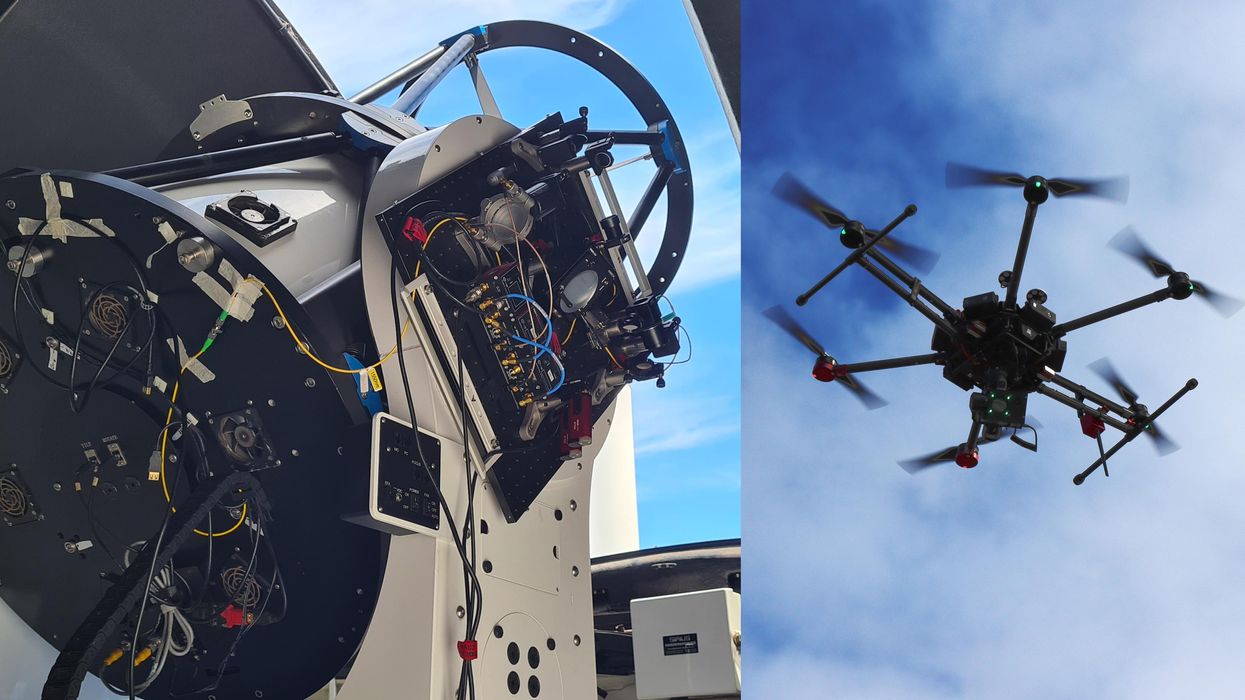
Optical fiber has long since replaced copper wiring in core information networks. But that’s not the case for free-space optical (FSO) communications using optical lasers to transmit data through the air. Despite FSO having the potential to provide orders of magnitude more data capacity compared to traditional radio frequency communications that space missions currently rely on, but the technology has been stuck on the launch pad because of atmospheric interference that can absorb and scatter the signals, as well as the strict acquisition and tracking requirements for communicating between ground stations and orbiting satellites.
But now researchers from the International Centre for Radio Astronomy Research in Western Australia have developed a coherent FSO link operating at 1550 nm across a turbulent atmosphere between an optical ground terminal and a retroreflector mounted on an airborne drone. Their findings were published this October in Scientific Reports.
“We’ve been able to maintain a robust single mode fiber coupling resulting in an uninterrupted 100 gigabits per second optical data link,” says Shane Walsh, team leader of the project. “We do this by tracking the drone at angular rates up to 1.5 degrees a second—the equivalent of tracking a satellite in low earth orbit (LEO).”
With the greater data capacity of coherent communications and its compatibility with standard fiber optics, Walsh says the way is now open to developing terabits per second communications between LEO satellites and suitably equipped ground stations. “You can think of it as taking ground to space communications from dial up speeds to super-fast broadband speeds,” he adds.
“This multidisciplinary approach by the researchers and the test results are impressive,” says Alan Willner, a professor of electrical engineering specializing in optical communications at the University of Southern California. “They appear to have mitigated some of the key issues with free space optical communications such as communicating through turbulence, and in pointing and tracking at speeds needed to communicate with low orbiting satellites.”
Benjamin Dix-Matthews, who is researching the optics for the project, describes the set-up used. A PlaneWave Instruments L-350 Drive Mount is employed to enable tracking of the target. Attached to it is an optical breadboard housing the tracking and acquisition systems. These include a GPS module for initial tracking, a closed-loop machine-vision (MV) system that provides intermediate acquisition and tracking, and a tip-tilt adaptive optics (AO) system consisting of a two-inch diameter mirror connected to a commercial piezo tip/tilt platform.
“We’re reaching the limits in what we can do, at least not without a lot of pain, in communicating using radio frequencies. So we will likely adopt new optical technologies. And I don’t see any obvious show-stoppers to further advances using the researchers approach.” —Alan Willner
“The tip/tilt AO system operates at 200 Hz,” says Dix-Matthews. “It plays a dual role of correcting beam wander of the outgoing beam to maintain pointing accuracy, and it also corrects the angle-of-arrival of the return beam to maintain fiber-coupling efficiency.”
Given the challenges “of tracking and dealing with turbulence, coupling light into a single mode fiber is no easy matter,” says Willner. “That the researchers are able to do so is noteworthy.”
To test the technology, Walsh says they set up the terminal on the roof of the Institute’s physics building, 34 meters above sea level. To simulate the angular motion of a LEO satellite, they employed a drone outfitted with a gimbal-mounted corner cube retroreflector that returns the 1550 nm signal, four green beacon LEDs for machine-vision tracking, and a camera for orienting the gimbal. Also included is GPS and a barometric altimeter to relay initial coordinates to the optical terminal.
The drone flew at an altitude of 120 meters at a line-of-sight distance of up to 700 meters for a laser beam-folded link length of 1.4 km. Initially, the gimbal was adjusted manually by the pilot so that the beacons were oriented towards the mount. At the next stage, the GPS module transmitted the drone’s position to the terminal computer, which enabled software to point the terminal at the target. With the target located, the MV loop closed and the mount-pointing was adjusted to track the drone beacons. The tip/tilt loop was then closed to provide fine-scale tracking. The MV and tip/tilt loops were run concurrently to maintain tracking and to correct for beam wander and wind buffeting.
“We conducted some thirty test flights, flying the drone in passes simulating the tracking rates needed for free-space optical links to satellites in LEO,” says Walsh. “And in spite of atmospheric turbulence and macroscopic motion, we were able to sustain a 100 gigabit per second link.”
“There’s a good reason why space agencies and major corporations are interested in free space optical communications,” says Willner. “We’re reaching the limits in what we can do, at least not without a lot of pain, in communicating using radio frequencies. So we will likely adopt new optical technologies. And I don’t see any obvious show-stoppers to further advances using the researchers approach.”
The terminal needs to be optimized further and the MV system will require changes for satellite use. Walsh says the next step is to test the technology with an aircraft flying at higher altitudes and after that, testing with a satellite would begin.
In addition, the researchers are developing a purpose-built optical communications ground station that they believe will lead to the commercialization of the technology. To this end, they are working with three space-related companies in Australia, says Walsh. “So we anticipate receiving our first LEO downlink some time in 2023, and hope to provide commercial high data-rate coherent optical communications to and from space in the next few years.”
Source: IEEE Spectrum Telecom Channel
